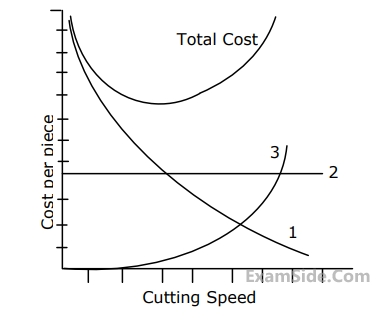1
GATE ME 2005
MCQ (Single Correct Answer)
+2
-0.6
A $$600$$ $$mm$$ $$ \times \,\,30\,\,mm$$ flat surface of a plate is to be finish machined on a shaper. The plate has been fixed with the $$600$$ $$mm$$ side along the tool travel direction. If the tool over-travel at each end of the plate is $$20$$ $$mm,$$ average cutting speed is $$8$$ $$m/min,$$ feed rate is $$0.3$$ $$mm/stroke$$ and the ratio of return time to cutting time of the tool is $$1:2,$$ the time required for machining will be
2
GATE ME 2005
MCQ (Single Correct Answer)
+2
-0.6
Two tools $$P$$ and $$Q$$ have signature $${5^ \circ } - {5^ \circ } - {6^ \circ } - {6^ \circ } - {8^ \circ } - {30^ \circ } - 0$$ and $${5^ \circ } - {5^ \circ } - {7^ \circ } - {7^ \circ } - {8^ \circ } - {15^ \circ } - 0$$ (both $$ASA$$) respectively. They are used to turn components under the same machining conditions. If $${h_p}$$ and $${h_Q}$$ denote the peak-to-valley height of surfaces produced by the tools $$P$$ and $$Q$$, the ratio $${h_P}/{h_Q}$$ will be
3
GATE ME 2005
MCQ (Single Correct Answer)
+2
-0.6
The figure below shows a graph, which qualitatively relates cutting speed and cost per piece produced.


The three curves $$1,2$$ and $$3$$ respectively represent
4
GATE ME 2005
MCQ (Single Correct Answer)
+2
-0.6
Spot welding of two $$1$$ $$mm$$ thick sheets of steel (density $$ = 8000kg/{m^3}$$ ) is carried out successfully by passing a certain amount of current for $$0.1$$ second through the electrodes. The resultant weld nugget formed is $$5$$ $$mm$$ in diameter and $$1.5$$ $$mm$$ thick. If the latent heat of fusion of steel is $$1400$$ $$kJ/kg$$ and the effective resistance in the welding operation is $$200\mu \Omega ,$$ the current passing through the electrodes is approximately
Paper analysis
Total Questions
Engineering Mathematics
13
Engineering Mechanics
6
Fluid Mechanics
4
Heat Transfer
8
Industrial Engineering
7
Machine Design
3
Production Engineering
11
Strength of Materials
8
Theory of Machines
6
Thermodynamics
6
More papers of GATE ME
GATE ME 2025
GATE ME 2024
GATE ME 2023
GATE ME 2022 Set 2
GATE ME 2022 Set 1
GATE ME 2020 Set 2
GATE ME 2020 Set 1
GATE ME 2019 Set 1
GATE ME 2019 Set 2
GATE ME 2018 Set 2
GATE ME 2018 Set 1
GATE ME 2017 Set 2
GATE ME 2017 Set 1
GATE ME 2016 Set 1
GATE ME 2016 Set 3
GATE ME 2016 Set 2
GATE ME 2015 Set 2
GATE ME 2015 Set 1
GATE ME 2015 Set 3
GATE ME 2014 Set 1
GATE ME 2014 Set 4
GATE ME 2014 Set 2
GATE ME 2014 Set 3
GATE ME 2014 Set
GATE ME 2014
GATE ME 2013
GATE ME 2012
GATE ME 2011
GATE ME 2010
GATE ME 2009
GATE ME 2008
GATE ME 2007
GATE ME 2006
GATE ME 2005
GATE ME 2004
GATE ME 2003
GATE ME 2002
GATE ME 2001
GATE ME 2000
GATE ME 1999
GATE ME 1998
GATE ME 1997
GATE ME 1996
GATE ME 1995
GATE ME 1994
GATE ME 1993
GATE ME 1992
GATE ME 1991
GATE ME 1990
GATE ME 1989
GATE ME 1988
GATE ME 1987
GATE ME
Papers
2025
2024
2023
2014
2013
2012
2011
2010
2009
2008
2007
2006
2005
2004
2003
2002
2001
2000
1999
1998
1997
1996
1995
1994
1993
1992
1991
1990
1989
1988
1987



